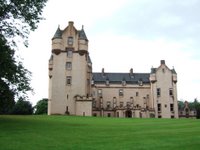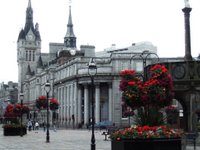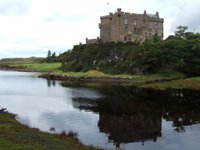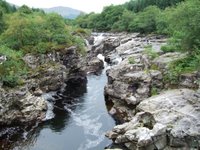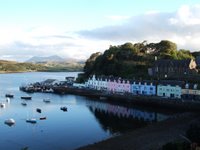 We left Dundee this morning in glorious sunshine with the forecasters promising the best day yet.
We left Dundee this morning in glorious sunshine with the forecasters promising the best day yet.Over the Tay Bridge is St Andrews where we enjoyed a very interesting tour of the castle and the old Cathedral. The castle has two mine tunnels beneath it. The first, the attack tunnel, was built from (what is now) a house opposite, trying to tunnel underneath the gatehouse and blow it up. The monks inside the castle found out and had three attempts to make a counter tunnel. They could only guess the direction to dig by the digging sounds that the attackers were making.
 Up above ground again we toured the cathedral ruins. One part that is left is a very high tower [Not the tower pictured] and the climb to the top affords marvelous views over St Andrews.
Up above ground again we toured the cathedral ruins. One part that is left is a very high tower [Not the tower pictured] and the climb to the top affords marvelous views over St Andrews. After walking around the town, we drove back through Dundee and Perth to Glamis Castle. This kept our royal theme of the last few days, as this was the childhood home of the Queen Mother. The visit was by guided tour, which was very interesting.
After walking around the town, we drove back through Dundee and Perth to Glamis Castle. This kept our royal theme of the last few days, as this was the childhood home of the Queen Mother. The visit was by guided tour, which was very interesting. We sat at their picnic tables and watched their very handsome highland cattle while we ate the delicious goodies we had purchased in St Andrews.
We sat at their picnic tables and watched their very handsome highland cattle while we ate the delicious goodies we had purchased in St Andrews. At Kirriemuir we visited JM Barrie's childhood home. It was just a humble cottage, which shows that talent can flourish in any environment. In the back yard was their washhouse - the original Wendy House.
At Kirriemuir we visited JM Barrie's childhood home. It was just a humble cottage, which shows that talent can flourish in any environment. In the back yard was their washhouse - the original Wendy House.Barrie had donated a camera obscura to his home-town in the 1930s. We have seen one before, but never one so clear, and the surrounding countryside, so vivid. The lady who demonstrated it to us, made it amusing by making a dog or trucks run over a little cardboard bridge which she would place on the image screen.
We then drove through the attractive town of Forfar to the Pitmuies Gardens. These are very simple, but attractive gardens.
Further
 on, past Brechin was our final attraction, Edzell Castle. This was a ruin of a once attractive castle, but the main attraction is the walled garden. It was built in 1604 and restored in the 1930s. The gardens are our favorite formal box hedge type of garden and attractive in their own right, but surrounding the garden is an amazing wall.
on, past Brechin was our final attraction, Edzell Castle. This was a ruin of a once attractive castle, but the main attraction is the walled garden. It was built in 1604 and restored in the 1930s. The gardens are our favorite formal box hedge type of garden and attractive in their own right, but surrounding the garden is an amazing wall.  One side is the castle, the other three feature themes of carved plaques: One wall the virtues, one the arts and one the planetary gods. The summer-house and well have survived but not the bath house. It was a tranquil, romantic garden: quite an amazing find.
One side is the castle, the other three feature themes of carved plaques: One wall the virtues, one the arts and one the planetary gods. The summer-house and well have survived but not the bath house. It was a tranquil, romantic garden: quite an amazing find.








